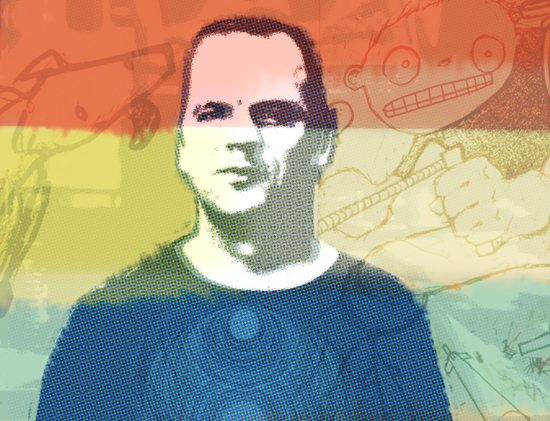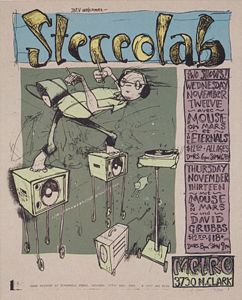In the world of band show posters, known as "gig" posters, there are few artists with the stature (physically as well as artistically) of Chicago's Jay Ryan. From his storefront screen printing facility in Skokie, Illinois, called The Bird Machine, Jay cranks out thousands of posters for famous and not-so-famous bands including his own, Dianogah. Gig posters have become recognized as a cool and collectible art form that are prized long after many of the bands whose shows they promote are no longer around. Along with graphic novels, gig posters have seen a surge in popularity that goes far beyond their core audience.
I recently caught up with Jay at the Daily Planet Rock and Art Poster Party to celebrate the 20th anniversary of Steve Walters' Screwball Press and he was kind enough answer a few questions:
Q: In one of your previous interviews, you mention one of your painting teachers, Peter Kursel, by name, but it doesn't say where you went to school. How important do you think a formal art education was for you and do you think having an art degree is a great advantage for artists in general?
Jay: I went to the University of Illinois in Urbana, which was the only school to which I applied where I couldn't get into the architecture program. I started in industrial design, but soon switched to painting, largely due to a cute girl in the painting program (and 19 years later we're still together). Peter Kursel was mentioned in that interview, but Roger Kotoske, Barbara Kendrick, Sarah Krepp, Tim van Laar and Dennis Rowan were all important to my education. I think Tim van Laar is the only one of those I've mentioned who is still teaching in Urbana.
While there are tons of exceptions, including some of my favorite artists, I think that a formal education is generally a good foundation for making work, so there's a sense of context to what you're doing. Learn the rules so you understand where the lines are, and then you're able to decide when you want to work inside the lines or draw outside of them.
For me, the "formal" part of the education played a minor role in what I now perceive that I learned in school. The figure drawing, line weight, color sense, painting techniques and proper way to cut foamcore were all important, but as I mentioned in that previous interview, I got more from a couple "lessons" I learned about how to redefine what a drawing could be, to lower my expectations away from "drawing well", and to be able to work around the tendency to freeze up when trying to create an image.
Q: In your book "100 Posters:134 Squirrels" you mention that one of your pieces, the cover for Michael Chabon's "The Final Solution" was originally colored in Photoshop then recreated using traditional screen printing techniques. As a traditional screen printer, what are your feelings regarding digitally created art as a medium? Do you use the computer at all at any stage of your creative process?
Jay: Generally, I don't use the computer for my poster work. I usually* pride myself on making my prints entirely with hand-drawn linework and text, and hand-cutting the separations for printing. I do use Photoshop when I design album covers or t-shirts for bands, but I use the program in the same way that I make my screenprints, by scanning in a pencil drawing, and coloring the layers in the same way I would by hand. This is useful when the project is something that's not going to be screenprinted, or isn't going to be printed by me.
* I say "usually", as I am currently without access to a good Xerox machine for making my key plate films, so for the last 3 or 4 months I have been scanning my pencil drawings into Photoshop and having them output as a film by the service bureau next door to my shop. So I can't technically claim to be computer-free right now.
Q: On the subject of the creative process, how do you work out your ideas? Much of your finished work seems to have a fresh, sketchy look to it. Do you keep a sketchbook or written journal of ideas?
Jay: No, I take forever to fill sketchbooks. I don't normally just draw for drawing's sake. I guess I get that itch scratched by pretty much all of the projects I work on, as I feel like they're all my personal work. I just go "Oh, okay, next is a Melvins print." I listen to the Melvins, and hope that something comes to me quickly.
Q: Has the recession affected the gig poster market? Screen printed gig posters seem like a great way for music fans and art lovers to get original limited edition artwork at an affordable price and I've got to say, as nice as the pieces look in the book reproductions, nothing beats seeing the richness and grain of hand pulled screen prints.
Jay: As a small business owner with employees, I have the same economic concerns as everyone who isn't a banker-pirate, oil baron, or overpaid conservative talkshow pundit. However, due to the fact that our business model is accidentally based on the idea of getting lots and lots of little paychecks instead of a couple of big paychecks, we're continuing to do slightly better every year.
Q: As a new and first time dad, do you find your perspective has changed in terms of balancing home and work and when will you give your daughter her first lesson in screen printing?
Jay: This is sort of an ongoing struggle, which we don't see resolving for a couple of years. My wife and I both run our own businesses, and we're trying to find the right ways to balance spending as much time as possible with the baby (who turns 6 months next week) while maintaining our respective careers. What we each do is unlike a job at the store, where you can take off for a year, then get another job at the store and things are basically the same. If I were to drop out of working for a year (or more), I think I'd lose some of my audience, and many of my clients. As for lessons, we'll see if my daughter has any interest in what I do. At the moment, she's way more interested in getting her toes into her mouth.
________________ Many thanks to Jay Ryan for giving me a rare peek inside The Bird Machine. His posters have been published in two collections including the aforementioned "100 Posters:134 Squirrels" and "Animals and Objects In and Out of Water". His work and that of many other incredible gig poster artists can also be found at gigposters.com.






